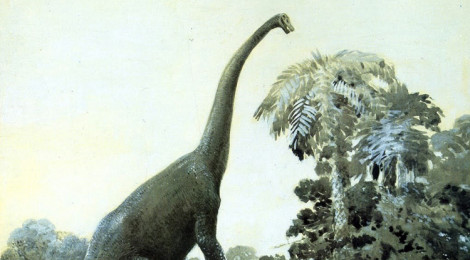
Behemoth – What Was It?
Featured image: A rearing diplodocus, painted in 1911 by Charles R. Knight
In the 40th chapter of Job, the Bible describes a fantastic creature known simply as “behemoth.”
Described as a grazing animal of great size and strength, it has captured the imaginations of millions. But what was this amazing beast?
For centuries, controversy has raged over the identity of behemoth. Some say it is a creature of pure myth. Others, that it is simply an ordinary animal. To others still, it is a remnant of an ancient world.
What is the truth?
The truth is that, while some answers may be forever beyond our grasp, there is still much that we can know. The key is to start with scripture and let the voice of history guide our thoughts.
Behemoth – just a myth?
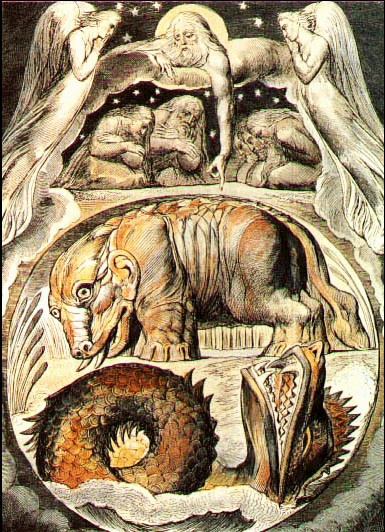
A watercolor from William Blake’s “Illustrations of the Book of Job.” Both behemoth (middle) and leviathan (bottom) are depicted in rather fantastical forms – typical of many old renderings.
There are many today who suggest that the behemoth is a mythological figure – an abstract representation of God’s power.
While both behemoth and leviathan (the enigmatic reptile described in Job 41) have been used figuratively in Jewish literature, these writings came much later and do not necessarily reflect on the book of Job. In fact, there are several good reasons to suggest that Job 40 and 41 are describing real animals:
- Throughout the previous chapter, God teaches Job through allusions to real animals. To suddenly shift to talking about metaphorical animals would be arbitrary and strange.
- The animals themselves are described in a very down-to-earth (if somewhat poetic) fashion. Behemoth in particular is not some cosmic force – just an animal that eats grass and likes the shade.
- The discussion on these beast focuses largely on their physical attributes. This would only make sense if the animals actually had physical attributes to talk about.
In light of these points, it makes sense to conclude that both behemoth and leviathan were real animals.
The Nature of the Beast
So what was behemoth? Before we can answer that, we must look to scripture.
15 “Behold now, Behemoth, which I made as well as you;
He eats grass like an ox.
16 “Behold now, his strength in his loins
And his power in the muscles of his belly.
17 “He bends his tail like a cedar;
The sinews of his thighs are knit together.
18 “His bones are tubes of bronze;
His limbs are like bars of iron . . .
From these first passages (Job 40:15-18), we learn a few things:
- Behemoth was a grazing herbivore (verse 15)
- It was tall and powerful (verses 16 and 18)
- It had a prominent, swaying tail (verse 17)
The book continues:
19 “He is the first of the ways of God;
Let his maker bring near his sword.
20 “Surely the mountains bring him food,
And all the beasts of the field play there.
21 “Under the lotus plants he lies down,
In the covert of the reeds and the marsh.
22 “The lotus plants cover him with shade;
The willows of the brook surround him.
23 “If a river rages, he is not alarmed;
He is confident, though the Jordan rushes to his mouth.
24 “Can anyone capture him when he is on watch,
With barbs can anyone pierce his nose?
Here, we learn a few more things:
- It was one of God’s more spectacular creatures (verse 19)
- It was a creature on home both on land (verse 20) and, to some extent, in the water (verse 21 and 22)
- It was a formidable creature, undaunted by natural disasters (verse 23) and incapable of being threatened (verse 24)
To summarize, the behemoth was a large, grazing animal with a prominent, swaying tail. It was tall and formidable, frequenting both mountains and riversides.
Having established these facts, we can begin to unravel the mystery of this beast.
Elephant or Hippopotamus?
It has often been suggested that behemoth was an elephant.
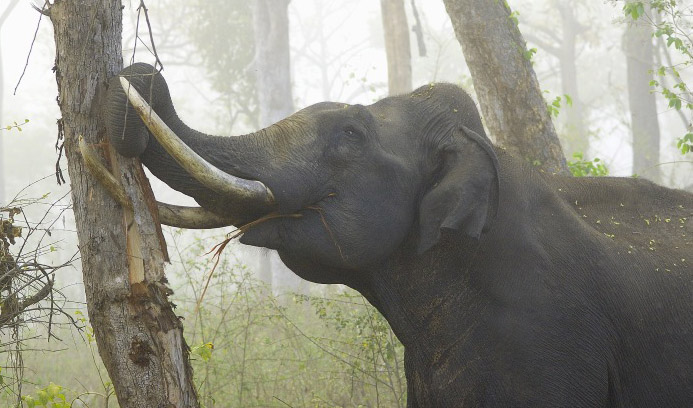
An asian elephant strips bark off of a tree. Source
At first, this makes sense. The elephant is, of course, a tall, powerful animal. It eats grass and frequents both aquatic and terrestrial environments.
Others have said that behemoth was a hippopotamus.
Again, this makes some kind of sense. Like the elephant, the hippo is a powerful grazing animal that spends time in the water.
Despite these superficial points, there are a few problems with these two options.
The hippopotamus spends almost all of its time in the water, yet behemoth often fed near mountains.
The elephant may spend more of its time on land, but neither it, nor the hippopotamus can lay claim to the behemoth’s large, cedar-like tail.
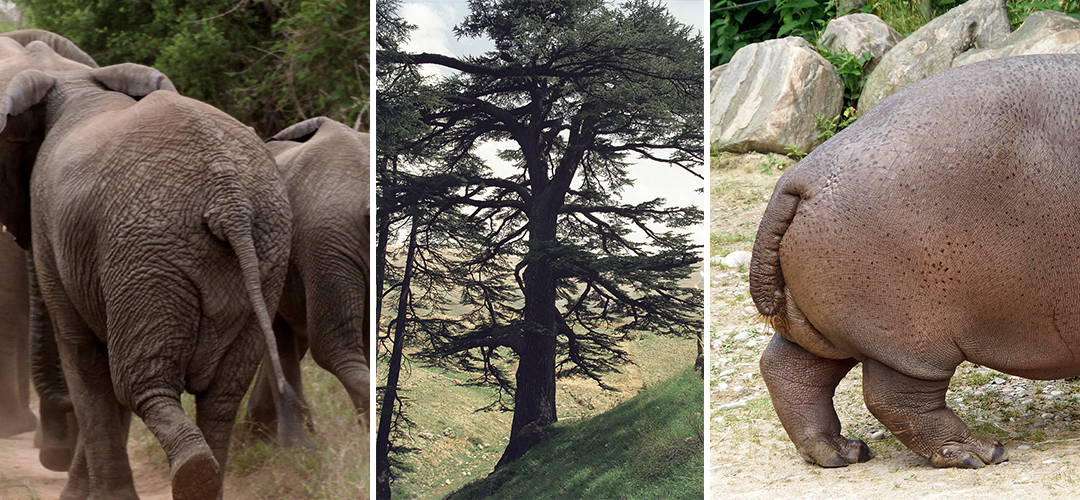
The tails of both the elephant and the hippopotamus are flimsy, and insignificant. The tail of behemoth is described as being “like a cedar.” Image sources: hippo, cedar
It is often what the Bible does not say about behemoth that is most telling, however.
If one were describing an elephant, one might be expected to mention its strong, pillar-like legs, its broad ears, and its long, flexible trunk. While Job 40 does describe behemoth as tall, with limbs like “bars of iron,” it mentions none of these other features.
Similarly, if one were to describe a hippopotamus, one might focus on its short, robust build, its gaping jaws, and its formidable tusks. While behemoth is described as powerful and formidable, it is also tall and muscular, with no mention of jaws at all, much less tusks.
[feature_box style=”8″ only_advanced=”There%20are%20no%20title%20options%20for%20the%20choosen%20style” alignment=”center”]
“Can anyone pierce his nose?”
 An Egyptian hippo hunt as depicted in the Tomb of Meruka.
An Egyptian hippo hunt as depicted in the Tomb of Meruka.
To modern readers, God’s challenge to pierce the nose of behemoth may seem insignificant. It is important to note, however, that piercing the nose was a tactic used by the ancient Egyptians for the specific purpose of hunting and killing hippopotamus!1)Paul, Mart-Jan. “Behemoth and leviathan in the book of Job.” Journal of Creation 24, no. 3 (December 2010): 95.
By making this comparison, it is likely that God is actually comparing behemoth to the hippopotamus, declaring the superiority of the former. This is a fatal blow to the behemoth-as-hippopotamus theory.
[/feature_box]
Was Behemoth a Dinosaur?
In recent decades, many have considered the possibility that behemoth was a kind of dinosaur, usually one of the long-necked sauropods.
Is there anything to this idea? To evaluate this, we must first recall the natural history of dinosaurs:
[divider style=”10″]
The first dinosaurs were created on Day 6, alongside Adam and the other land animals. Though no skeletal remains are known from this time period, we know from reading Genesis 1:302)Genesis 1:30 ” ‘and to every beast of the earth and to every bird of the sky and to every thing that moves on the earth which has life, I have given every green plant for food’; and it was so.”, that these original species (about 50-90 in number3)“The Ark’s Dinosaurs.” Answers in Genesis. Accessed March 26, 2016. https://answersingenesis.org/dinosaurs/when-did-dinosaurs-live/arks-dinosaurs/. ) were designed for eating plants.
Dinosaurs diversified in the centuries between Eden and the flood4)It is important for readers to note that the idea of one parent species dividing into multiple child species is not the same as Darwinian evolution. Both natural selection and speciation are real, observable processes, but involve pre-existing genetic information being sorted and, ultimately, reduced. This is the opposite of what is required by the Theory of Common Descent.. During this time, many kinds of dinosaurs adopted carnivorous lifestyles. By the end of the Antediluvian (pre-flood era), the number of dinosaur species had grown to over 5005)“How Many Types of Dinosaurs Are Known?” U.S. Geological Survey Publications Warehouse. Accessed March 26, 2016. http://pubs.usgs.gov/gip/dinosaurs/types.html. – almost all of which went extinct during the flood of Noah.
Those dinosaurs that were with Noah on the ark survived the flood and went on to recolonize the land alongside the other survivors. While never reclaiming their original magnificence, historical evidence suggests that dinosaurs lingered on in the Postdiluvian (post-flood era) for some time before finally going extinct.
[divider style=”10″]
What kind of dinosaur?
The first thing we must do is resist the urge to tie behemoth to any one known species of dinosaur (e.g. brachiosaurus, argentinosaurs, etc.).
Almost all of the dinosaurs found in our museums and picture books are known from fossils laid down by Noah’s flood. They are antediluvian species!
While there is some disagreement over the exact dating of Job, the story almost certainly took place after the flood of Noah. Therefore, behemoth, whatever it was, was a postdiluvian animal!
This doesn’t mean that behemoth wasn’t a dinosaur, of course, only that it would have been a species of its own, not one of our classic favorites.
Behemoth is usually considered to be a long-necked sauropod dinosaur, the largest of the dinosaur kinds
This actually fits the description of behemoth quite well. Sauropods were large, powerful animals with long, swaying tails.
While they probably did not wallow around in the water like hippos, it is reasonable to assume that, like elephants, they would congregate near water sources.
Sauropods are also one of the few dinosaurs known to have “eaten grass like an ox.”6)“Dung Reveals Dinosaurs Ate Grass.” LiveScience.com. Accessed March 29, 2016. http://www.livescience.com/3912-dung-reveals-dinosaurs-ate-grass.html.
Conclusion
A plain reading of Job 40 makes it clear that behemoth cannot be equated with any known modern animal.
While dinosaurs are likely extinct today, a biblical reading of natural history allows for the possibility that behemoth was some kind of postdiluvian dinosaur.
The similarity of the description to the grazing sauropods further supports this possibility.
Still, it is important to realize that we will probably never know what behemoth was for sure. Despite the apparent fit with sauropods, there is room for debate (for example, if it is a sauropod, then why does the Bible never mention its long neck?). This is one of the problems with trying to identify a creature based on description alone (especially poetic description).
Despite the mysteries that surround this creature, behemoth is a powerful testament to God’s majesty and provides an excellent opportunity to explore the links between God’s word and God’s world.
References
| ↑1 | Paul, Mart-Jan. “Behemoth and leviathan in the book of Job.” Journal of Creation 24, no. 3 (December 2010): 95. |
|---|---|
| ↑2 | Genesis 1:30 ” ‘and to every beast of the earth and to every bird of the sky and to every thing that moves on the earth which has life, I have given every green plant for food’; and it was so.” |
| ↑3 | “The Ark’s Dinosaurs.” Answers in Genesis. Accessed March 26, 2016. https://answersingenesis.org/dinosaurs/when-did-dinosaurs-live/arks-dinosaurs/. |
| ↑4 | It is important for readers to note that the idea of one parent species dividing into multiple child species is not the same as Darwinian evolution. Both natural selection and speciation are real, observable processes, but involve pre-existing genetic information being sorted and, ultimately, reduced. This is the opposite of what is required by the Theory of Common Descent. |
| ↑5 | “How Many Types of Dinosaurs Are Known?” U.S. Geological Survey Publications Warehouse. Accessed March 26, 2016. http://pubs.usgs.gov/gip/dinosaurs/types.html. |
| ↑6 | “Dung Reveals Dinosaurs Ate Grass.” LiveScience.com. Accessed March 29, 2016. http://www.livescience.com/3912-dung-reveals-dinosaurs-ate-grass.html. |
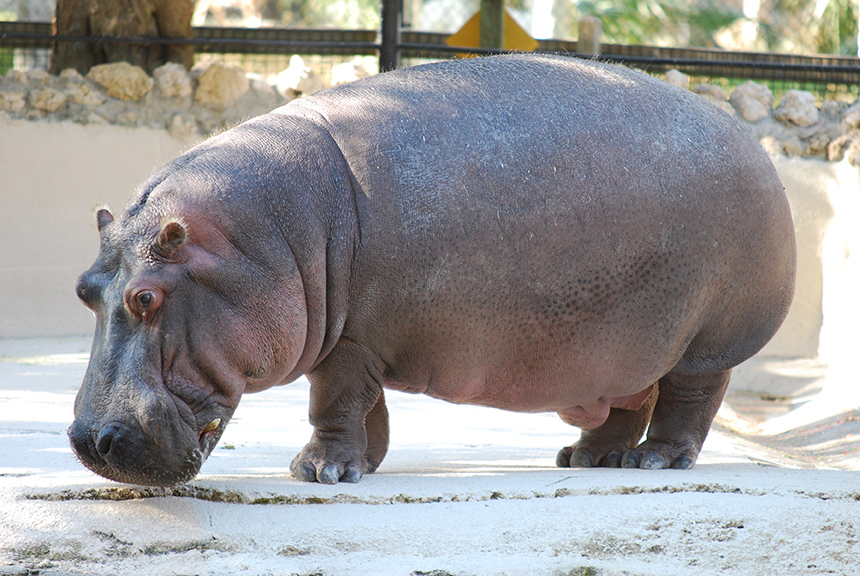

Comments are closed, but trackbacks and pingbacks are open.